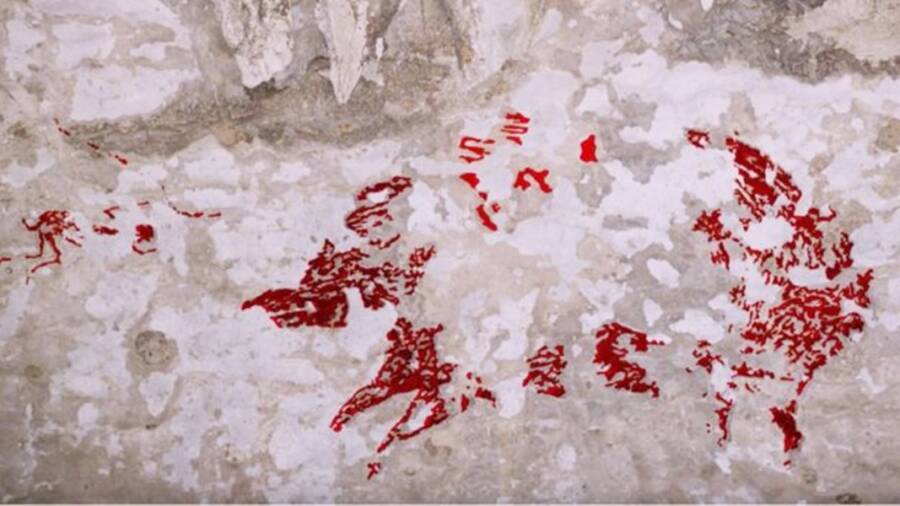“Ancient Cave Art: Is This 44,000-Year-Old Masterpiece Revealing Humanity’s First Tale?”
What if I told you that figurative painting—long perceived as a European invention—has its roots nestled in a cave in Sulawesi, Indonesia? This startling revelation flips the script on what we thought we knew about the origins of art! This is where the story takes a fascinating turn: a cave painting that could be over 44,000 years old depicts a hunting scene, challenging our European-centric view of art history. Imagine that—ancient humans telling stories through art in what is now Indonesia, possibly long before their European counterparts picked up a brush! So, what do these findings mean for the art history narrative? Join me as we unravel this captivating tale that not only rewrites art history but also compels us to reconsider the very origins of human creativity. LEARN MORE.
“It has always been assumed that the tradition of figurative painting arose in Europe… This shows the tradition does not have its origins in Europe.”

Ratno SardiScientists have determined a cave painting depicting what looks to be a hunting scene is more than 44,000 years old.
An Indonesian archaeologist named Hamrullah — who is also an avid caver — climbed up a fig tree to access the narrow entryway of a cave in southern Sulawesi. There, the researcher discovered an incredible sight: a brown-reddish rock painting unlike any other found before.
Hamrullah snapped a blurry photo of the rock art on his phone and sent it to his Australian colleague, Adam Brumm, who was stunned by what he saw.
“I think I said the characteristic Australian four-letter word out very loud,” said Brumm. According to the BBC, the incredible rock art appeared to show a hunting scene which involved wild pigs and a small-sized buffalo species known as anoa, two of the island’s native fauna.
Not only that, the painting also appeared to show these animals being hunted by figures that look human but also possessed animal traits like tails and snouts. In one section of the painting, an anoa seemed to be surrounded by several of these human-like figures who are wielding weapons.
Although the rock art isn’t the oldest human-made drawing — that title belongs to a tiny sketch found on a rock fragment in South Africa from 73,000 years ago — researchers believe the Sulawesi painting could be the world’s oldest clearly narrative artwork as scientists have determined the painting to be at least 44,000 years old. In other words, it could be the oldest story scene ever recorded by human beings.
“I’ve never seen anything like this before. I mean, we’ve seen hundreds of rock art sites in this region, but we’ve never seen anything like a hunting scene,” explained Brumm, a researcher at Australia’s Griffith University and co-author of the study which was published in the journal Nature.

Maxime Aubert/PA Wire
The scene in its entirety depicts the hunt of wild pigs and a small buffalo known on the island as anoa.
To determine the cave painting’s true age, researchers led by archaeologist Maxime Aubert analyzed what is known as calcite “popcorn” that had built up on the painting after tens of thousands of years. The radioactive uranium in the mineral had slowly decayed into thorium and by measuring the different levels of isotopes researchers were able to determine the age of the popcorn on each section of the painting.
They found that the calcite popcorn on one of the painting’s wild pigs began forming at least 43,900 years ago while deposits on two of the scene’s anoas dated back to more than 40,900 years ago, making the painting one of the oldest cave drawings found to date and — possibly — the oldest painted story in the world.
It is still challenging for archaeologists to accurately date rock paintings like the one found at Sulawesi’s Leang Bulu’Sipong 4 cave site due to the tools used to create such artworks. These paintings are often made with raw materials like charcoal which could have formed much earlier than the drawings themselves.
It is partly why figurative artworks in Europe, like the ones in the Chauvet Cave in France and the El Castillo in Spain which date between 30,000 to 40,000 years ago, were believed to be much older than those found in the caves across Africa, Asia, and Australia.
“It has always been assumed that the tradition of figurative painting arose in Europe,” says Alistair Pike, an archaeologist at England’s University of Southampton. “This shows the tradition does not have its origins in Europe.”

AlamyThe Lascaux Caves in southwestern France feature clearly narrative scenes in rock art dated to around 17,000 years ago.
Indeed, in 2014, many other rock paintings were found in locations around Sulawesi and its neighboring island of Borneo dating further back than the European Ice Age. So far, there have been at least 242 caves or shelters in Sulawesi where scientists have discovered such images.
Furthermore, the part-human part-animal figurines — known in mythology as therianthropes — depicted in the newly discovered cave painting could signify the ability among early humans in Sulawesi to imagine things outside of the natural world.














